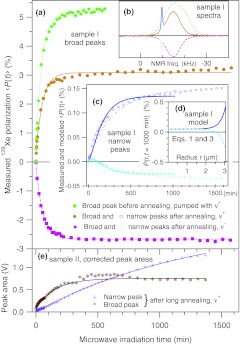Figure 3.
(a) Measured DNP polarization of 129Xe in the glassy matrix (broad peak, sample I) versus microwave irradiation time t at ν+ = 140.067 GHz (homogeneous, diamonds; annealed, circles) and ν− = 140.166 GHz (annealed, squares). The lines are exponential fits. (b) Corresponding 129Xe spectra after 9 hours of DNP (homogeneous: ν+, dotted; annealed: ν+, solid, and ν−, dashed). (c) Measured average DNP polarization in pure-Xe clusters (narrow peak, sample I) after annealing (ν+, circles; ν−, squares). Note the significantly lower polarizations compared to the broad peaks in (a). Fits of the spherical-cluster model to the combined ν+ and ν− data over 0 < t < 1030 min are shown for continuous (dashed-dotted) and bottleneck (solid and dashed) boundary conditions. (d) Modelled radial dependence of the local polarization in a cluster of radius R = 3.65 μm in steady state (ν+: solid, ν−: dashed). The cluster core achieves thermal polarization in both cases, since DNP only penetrates into the cluster on the order of spin-diffusion depth. Note a ten-fold lower internal boundary polarization compared to the external case (a). (e) Measured areas under the narrow (crosses) and broad (stars) peaks in sample II as a function of time at ν+ = 140.0616 GHz. The lines are exponential fits. The measured chamber temperature was (a-c) 1.59 ± 0.02 K; (e) 1.600 K.

